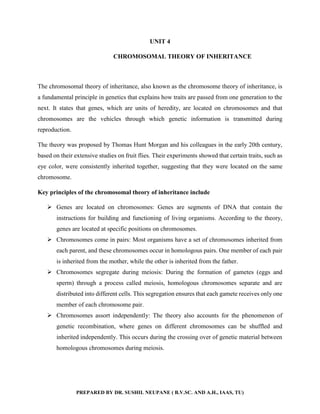
UNIT 4-CHROMOSOMAL INHERITANCE.pdf
- 1. PREPARED BY DR. SUSHIL NEUPANE ( B.V.SC. AND A.H., IAAS, TU) UNIT 4 CHROMOSOMAL THEORY OF INHERITANCE The chromosomal theory of inheritance, also known as the chromosome theory of inheritance, is a fundamental principle in genetics that explains how traits are passed from one generation to the next. It states that genes, which are units of heredity, are located on chromosomes and that chromosomes are the vehicles through which genetic information is transmitted during reproduction. The theory was proposed by Thomas Hunt Morgan and his colleagues in the early 20th century, based on their extensive studies on fruit flies. Their experiments showed that certain traits, such as eye color, were consistently inherited together, suggesting that they were located on the same chromosome. Key principles of the chromosomal theory of inheritance include Genes are located on chromosomes: Genes are segments of DNA that contain the instructions for building and functioning of living organisms. According to the theory, genes are located at specific positions on chromosomes. Chromosomes come in pairs: Most organisms have a set of chromosomes inherited from each parent, and these chromosomes occur in homologous pairs. One member of each pair is inherited from the mother, while the other is inherited from the father. Chromosomes segregate during meiosis: During the formation of gametes (eggs and sperm) through a process called meiosis, homologous chromosomes separate and are distributed into different cells. This segregation ensures that each gamete receives only one member of each chromosome pair. Chromosomes assort independently: The theory also accounts for the phenomenon of genetic recombination, where genes on different chromosomes can be shuffled and inherited independently. This occurs during the crossing over of genetic material between homologous chromosomes during meiosis.
- 2. PREPARED BY DR. SUSHIL NEUPANE ( B.V.SC. AND A.H., IAAS, TU) Expression of genes in their phenotypes The expression of genes refers to the process by which the information encoded in genes is used to produce a specific phenotype, which is the observable characteristics or traits of an organism. Gene expression involves the conversion of genetic information into functional products, such as proteins or non-coding RNAs, that perform specific functions within cells and contribute to the development and functioning of an organism. The process of gene expression can be summarized in the following steps: Transcription: In the nucleus of a eukaryotic cell, the DNA sequence of a gene is transcribed into a messenger RNA (mRNA) molecule by an enzyme called RNA polymerase. This step involves the unwinding of the DNA double helix and the synthesis of a complementary RNA strand using one of the DNA strands as a template. RNA processing: The newly synthesized pre-mRNA molecule undergoes several modifications before it can be translated into a protein. These modifications include the removal of non-coding regions called introns and the joining together of coding regions called exons. The processed mRNA molecule is then ready for export to the cytoplasm. Translation: In the cytoplasm, the mRNA molecule interacts with ribosomes, which are cellular structures responsible for protein synthesis. Transfer RNA (tRNA) molecules, each carrying a specific amino acid, bind to the mRNA molecule at the ribosome, and the sequence of codons on the mRNA is translated into a specific sequence of amino acids. This process results in the synthesis of a polypeptide chain, which folds into a functional protein. Protein folding and modification: The newly synthesized polypeptide chain undergoes folding and modification processes to acquire its functional three-dimensional structure. These processes may involve the assistance of chaperone proteins or post-translational modifications, such as the addition of sugar molecules or phosphate groups. Protein function: The functional protein performs specific tasks within the cell or organism. Proteins can have diverse functions, including enzymatic activities, structural roles, signaling functions, and regulatory functions. The specific functions of proteins contribute to the development, growth, and maintenance of the organism and determine its observable traits or phenotypes.
- 3. PREPARED BY DR. SUSHIL NEUPANE ( B.V.SC. AND A.H., IAAS, TU) It is important to note that not all genes code for proteins. Some genes encode functional RNA molecules, such as transfer RNA (tRNA), ribosomal RNA (rRNA), or regulatory RNAs, which have important roles in various cellular processes. TAKE AWAY MESSAGE The chromosomal theory of inheritance provided a mechanistic explanation for the patterns of inheritance observed in classical genetics experiments. It laid the foundation for our understanding of how genetic information is passed from one generation to the next and forms the basis of modern genetics. The expression of genes is regulated by a complex network of mechanisms that control when and where genes are expressed. These mechanisms ensure that genes are activated or repressed in a coordinated manner, allowing cells and organisms to respond to their environment and develop properly. Genetic variations or mutations can also affect gene expression, leading to differences in phenotypes among individuals.
